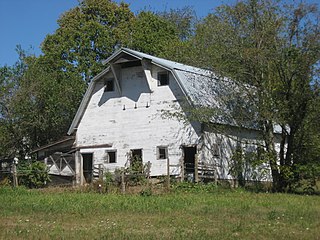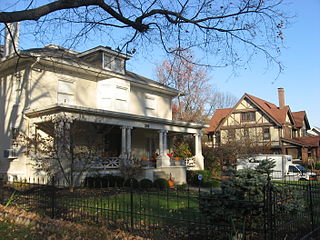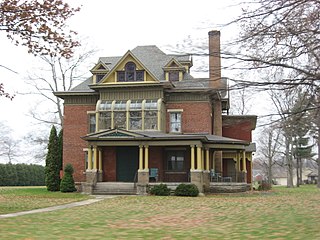
The Maj. Isaac C. Elston House, also known as Elston Homestead, is a historic home located at Crawfordsville, Montgomery County, Indiana, United States. It was the home of Maj. Isaac Compton Elston, who fought in the War of 1812 and the Black Hawk War. When he was 39, he moved to Indiana and became a frontier merchant, banker and financier. The Home was given to Wabash College by his grandson, Isaac Compton Elston, Jr. (1873-1964) and is now used as the President's home.

Vernon Historic District is a national historic district located in Vernon and Vernon Township, Jennings County, Indiana. It encompasses 42 contributing buildings and 3 contributing sites in Vernon. The district largely developed between about 1830 and 1900, and includes notable examples of Italianate, Greek Revival, and Federal style architecture. Notable contributing resources include the Jennings County Courthouse (1859), American House tavern, "Rat Row" apartments, Jacob Clinton House (1834), nures drug store (1853),(odd fellows lodge)(1853),Judge Hickman New House (1832), John Bassnett House (1844), Gen. Robert S. Foster House (1840), Methodist Church (1817), Vernon Presbyterian Church (1832), Baptist Church (1871), a stone arch (1832), Tunnel Mill site, and Vinegar Mill site.

Franklin Street Commercial Historic District is a national historic district located at Michigan City, LaPorte County, Indiana. The district encompasses 73 contributing buildings and 1 contributing object in the central business district and surrounding residential section of Michigan City. It developed between about 1875 and 1955, and includes examples of Italianate, Gothic Revival, Queen Anne, Classical Revival, and Tudor Revival style architecture. Located in the district is the separately listed Michigan City Post Office (1909-1910). Other notable buildings include the Staiger House, Earl House, M & M Diner (1955), Zorn Building (1907), St. Paul's Lutheran Church (1876) and rectory (1888), First Federal Savings Bank, Aicher Block (1914), Brinkman Building, Trinity Episcopal Church (1889), Merchants National Bank Building (1926), Ledbetter Building (1908), Rodenbeck Saloon, First Methodist Episcopal Church (1922), Barker Hall (1929), Masonic Temple (1922-1923), and the Salvation Army Building (1925).

Haskell and Barker Historic District is a national historic district located at Michigan City, LaPorte County, Indiana. The district encompasses 205 contributing buildings, 3 contributing structures, and 1 contributing object in a predominantly residential section of Michigan City. The district is named for the Haskell and Barker manufacturing company. It developed between about 1860 and 1960, and includes examples of Italianate, Gothic Revival, Queen Anne, Colonial Revival, Tudor Revival, and Bungalow / American Craftsman style architecture. Located in the district are the separately listed John H. Barker Mansion and First Congregational Church of Michigan City. Other notable buildings include the St. Stanislaus Koska Church (1922-1926), Rectory (1938), and Convent (1938), Consumer Service Company (1922), Michigan City School of Fine Arts (1908), Gilmore-Gardner Building (1925), Porter-Carrigan House (1895), Hutchinson House (1875), St Mary of the Immaculate Conception Catholic Church (1868) and Convent (1905), and Hartke House.

Indiana and Michigan Avenues Historic District is a national historic district located at LaPorte, LaPorte County, Indiana. The district encompasses 223 contributing buildings and one contributing site in a predominantly residential section of LaPorte. It developed between about 1860 and 1963, and includes examples of Italianate, Queen Anne, Colonial Revival, Prairie School, and Bungalow / American Craftsman style architecture. Located in the district is the separately listed Francis H. Morrison House. Other notable buildings include the Hobart M. Cable, Jr., House, Rear Admiral R. R. Ingersoll Residence (1908), John Secor House, Swan-Anderson House (1870), Carnegie Library (1920), Emmett Scott House (1915), Frank Osborn House, Henry McGill House, First Presbyterian Church (1862), Winn House, First Church of Christ Scientist, and St. Paul's Episcopal Church (1895-1898).

Plymouth Northside Historic District is a national historic district located at Plymouth, Marshall County, Indiana. The district encompasses 141 contributing buildings, 2 contributing sites, 6 contributing structures, and 3 contributing objects in a predominantly residential section of Plymouth. It developed between about 1870 and 1940, and includes examples of Italianate, Gothic Revival, Queen Anne, Colonial Revival, Tudor Revival, Neoclassical, and Renaissance Revival style architecture. Located in the district is the separately listed Marshall County Courthouse. Other notable contributing resources include Magnetic Park, First United Methodist Church (1914-1915), J.C. Capron House (1900), Samuel Schlosser House (1910-1911), Clay Metsker House (1917-1918), Plymouth Church of the Brethren (1950-1951), Logan-Stanley Fountain, Stevens House (1895), and First Presbyterian Church (1896-1897).

Plymouth Southside Historic District is a national historic district located at Plymouth, Marshall County, Indiana. The district encompasses 91 contributing buildings, 2 contributing structures, and 1 contributing object in a predominantly residential section of Plymouth. It developed between about 1853 and 1953, and includes examples of Italianate, Greek Revival, Queen Anne, Colonial Revival, and Tudor Revival style architecture. Notable contributing resources include the John McFarlin, Jr., House, Trinity United Methodist Church (1926), Bible Baptist Church (1894), Felke Florist and Greenhouse (1922), John Soice Residence, Westervelt-Marble Residence, and Edwards-Gambel Residence (1856).

North Washington Street Historic District is a national historic district located in the city of Bloomington of Monroe County, Indiana. The district encompasses 35 contributing buildings and 6 contributing structures in a predominantly residential section of Bloomington. It developed between roughly 1870 and 1929, and includes notable examples of Queen Anne, Classical Revival, and Bungalow/American Craftsman style architecture. Located in the district is the separately listed Morgan House. Other notable buildings include the Showers-Graham House, Showers-Myers House, Teter House, and Washington Terrace Apartments (1929).

Ellettsville Downtown Historic District is a national historic district located at Ellettsville, Monroe County, Indiana. The district encompasses 50 contributing buildings in the central business district and surrounding residential sections of Ellettsville. It developed between about 1840 and 1953, and includes notable examples of Queen Anne, Early Commercial, Gothic Revival, and Bungalow/American Craftsman style architecture. Notable buildings include the Robert Stimson House, May Presley House, Bradford House, George W. Fletcher House, Wickens House (1909), Capt. Gilbert Perry House, I.O.O.F. Building, Town Hall (1927), Masonic Building (1895), Knights of Pythias Building, First United Methodist Church (1900), and First Baptist Church (1909).

Maple Grove Road Rural Historic District is a national historic district located in Bloomington Township and Richland Township, Monroe County, Indiana. The district encompasses 69 contributing buildings, 7 contributing sites, 8 contributing structures, and 30 contributing objects in a rural area near Bloomington. The district developed between about 1828 and 1950, and include notable examples of Gothic Revival and Greek Revival style architecture. The contributing elements are located on 12 farmsteads. Located in the district is the separately listed Daniel Stout House.

Elston Grove Historic District is a national historic district located at Crawfordsville, Montgomery County, Indiana. The district encompasses 138 contributing buildings and 8 contributing structures in a predominantly residential section of Crawfordsville. It developed between about 1835 and 1935, and includes notable examples of Italianate, Queen Anne, and Colonial Revival style architecture. Located in the district are the separately listed Col. Isaac C. Elston House, Henry S. Lane House, and Gen. Lew Wallace Study. Other notable buildings include the Galey House (1848), Campbell House (1852), T.S. Scott House, Powers House (1862), Blair House, Hadley and Hornaday Houses (1878), Alfrey House (1885), Detchon House, Ashley House, Snyder House, and Voris House.

Martinsville Commercial Historic District is a national historic district located at Martinsville, Morgan County, Indiana. The district encompasses 75 contributing buildings and 1 contributing object in the central business district of Martinsville. It developed between about 1847 and 1947, and includes notable examples of Italianate, Classical Revival, and Tudor Revival style architecture. Located in the district are the separately listed Morgan County Courthouse and Blackstone House and Martinsville Telephone Company Building. Other notable buildings are the Martinsville Public Library, Martinsville City Hall (1917), Martinsville Post Office, Pitkin Building, Barskin's Department Store (1922), Indiana Theater, Steven's House / Building, Hale Building, Interurban Station, Union Block (1866), and First Christian Church (1891) and Annex (1927).

Morgantown Historic District is a national historic district located at Morgantown, Morgan County, Indiana. The district encompasses 34 contributing buildings in the central business district and surrounding residential sections of Morgantown. It developed between about 1840 and 1956, and includes notable examples of Greek Revival, Italianate, Late Gothic Revival, Queen Anne, and Bungalow/American Craftsman style architecture. Notable buildings include the Farmer's Cooperative Store / Blanche Crawford Building, First National Bank (1905), Obenshain Hotel (1860), Morgantown Town Hall (1900), Griffitt-Murphy House and Livery Bank (1895), Parkhurst House (1865), Redman's Lodge (1908), Wisby Hotel (1918), Telephone Exchange (1906), and Morgantown Methodist Episcopal Church complex (1923).

East Washington Street Historic District is a national historic district located at Martinsville, Morgan County, Indiana. The district encompasses 64 contributing buildings, 1 contributing site, and 7 contributing structures in a predominantly residential section of Martinsville. It developed between about 1869 and 1940, and includes notable examples of Queen Anne, Classical Revival, and Colonial Revival style architecture. Located in the district is the separately listed Neely House. Other notable buildings include the Martinsville Presbyterian Church, Sweet House, Gum House, Hubbard-Gano House, Frank Oak Branch House (1916), and Francesconi House.

Welborn Historic District is a national historic district located at Mount Vernon, Posey County, Indiana. The district encompasses 154 contributing buildings and 5 contributing structures in a predominantly residential section of Mount Vernon laid out by Jesse Welborn between 1822 and 1826. It developed between about 1840 and 1942, and includes notable examples of Greek Revival, Gothic Revival, Italianate, Romanesque Revival, and Colonial Revival style architecture. Notable contributing buildings include the Gov. Alvin P. Hovey House, Edward Sullivan House (1860), C.P. Klein House Johnson-Rosenbaum House (1905), St. Matthew's Catholic Church (1880), First Presbyterian Church (1872), Trinity Evangelical Church (1883), St. John's Episcopal Church (1892), Mount Vernon Post Office (1931).

West Washington Historic District is a national historic district located at South Bend, St. Joseph County, Indiana. It encompasses 330 contributing buildings in an upper class residential section of South Bend. It developed between about 1854 and 1910, and includes notable examples of Italianate, Greek Revival, and Romanesque Revival style architecture. Located in the district are the separately listed Morey-Lampert House, Oliver Mansion designed by Lamb and Rich, Second St. Joseph County Courthouse, South Bend Remedy Company Building, and Tippecanoe Place. Other notable buildings include the Bartlett House (1850), Birdsell House (1897), DeRhodes House designed by Frank Lloyd Wright, Holley House, Kaiser-Schmidt House, Listenberger-Nemeth House, Meahger-Daughterty House (1884), O'Brien House, Oren House, The People's Church (1889), St. Hedwig's Church, St. Patrick's Church (1886), St. Paul's Memorial United Methodist Church (1901), West House, and a row of worker's houses.

Haven Hubbard Home, also known as Hamilton Grove, is a historic sanitarium and national historic district located in Olive Township, St. Joseph County, Indiana. The district encompasses six contributing buildings and one contributing site on a former sanitarium originally developed as a working farm. It was developed between about 1860 and 1961, and includes examples of Second Empire, Queen Anne, Colonial Revival, and Collegiate Gothic architecture. Notable buildings include the Hubbard Homestead Home, Homestead Shed, Homestead Barn, Pump House, Epp Hall, and Haven Hubbard Home Parsonage (1960).

Dayton Historic District is a national historic district located at Dayton, Indiana, Tippecanoe County, Indiana. The district encompasses 82 contributing buildings and 1 contributing site in the central business district and surrounding residential sections of Dayton. It developed between about 1830 and 1952 and includes representative examples of Greek Revival, Italianate, Second Empire, and Bungalow / American Craftsman style architecture. Notable contributing resources include the Lantz Building (1941), Reincke-Hawkins House, Castle Block (1894), Baker-Yost House, First Presbyterian Church (1899), and Gladden-Goldsbury House.

Columbia City Historic District is a national historic district located at Columbia City, Whitley County, Indiana. The district encompasses 197 contributing buildings in the central business district and surrounding residential sections of Columbia City. It developed between about 1840 and 1937 and includes representative examples of Greek Revival, Italianate, Queen Anne, Second Empire, Classical Revival, and Bungalow / American Craftsman style architecture. Located in the district is the separately listed Whitley County Courthouse. Other notable contributing buildings include the former Whitley County Courthouse (1841), Adams Y. Hooper Residence, Thomas Shorb Residence, William McNagny Residence, Elisha L. McLallen House (1905), Whitley County Jail (1875), City Hall (1917), Peabody (Carnegie) Library (1919), U.S. Post Office (1935), Central Building (1872), D.B. Clugston Block (1889), Masonic Temple (1904), Church of the Brethren (1889), Presbyterian Church (1892), Methodist Church (1912), and Baptist Church (1917).

Holy Rosary–Danish Church Historic District, also known as Fletcher Place II, is a national historic district located at Indianapolis, Indiana. The district encompasses 183 contributing buildings in a predominantly residential section located in the central business district of Indianapolis. It was developed between about 1875 and 1930, and include representative examples of Italianate, Gothic Revival, Tudor Revival, and Renaissance Revival style architecture. Located in the district is the separately listed Horace Mann Public School No. 13. Other notable buildings include the John Kring House, Trinity Danish Evangelical Lutheran Church (1872), John Wands House (1857), Henry Homburg House, Samuel Keely House, Maria Wuensch Cottage, and Holy Rosary Catholic Church (1911-1925).
























